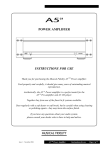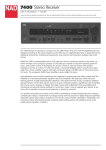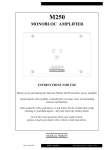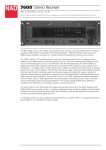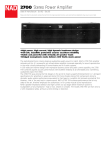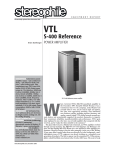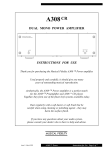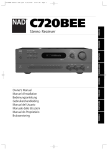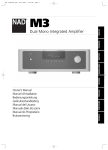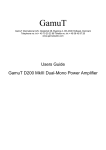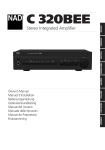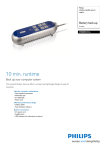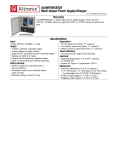Download NAD Electronics 3100 User's Manual
Transcript
3100 Integrated Amplifier Date of manufacture : ? Please note that this document contains the text from the original product brochure, and some technical statements may now be out of date For most manufacturers, the highest quality parts and most highly refined designs are used only in separate audio components-in preamplifiers, power amplifiers, and tuners. Integrated amplifiers are usually made to a less exalted standard, while all-in-one stereo receivers are regarded as compromise products suitable only for casual listeners. But not at NAD. NAD electronics are designed in modular form, and many of the same circuits are used in all product categories. The 3100 Integrated Amplifier, for example, combines NAD’s robust 2100 Power Amplifier with high-quality preamplifier circuitry derived from some of NAD’s finest preamplifiers. The pre- and power amplifier sections of the 3100 are joined by removable external jumpers that allow you to insert external processors such as a surroundsound unit or an electronic crossover for bi-amping in the signal path. The power amplifier section of the 3100 employs all of the NAD innovations described on pages 4 and 5. Like the 2100 Power Amplifier, it is conservatively rated at 50 watts/ channel for sine-wave test tones, while its Power Envelope circuit produces 200 to 330 watts channel of long-term tone-burst power for the dynamic waveforms of music. Its high-current output stage, impedance selector, and heavy-duty speaker terminals are designed to deliver maximum power to loudspeakers of any impedance. The preamplifier section of the 3100 contains the same low-noise MM/MC phono stage as the 1700 Preamplifier/ Tuner and the same switchable Infrasonic Filter, flexible two-way tape connections, Bass EQ, and ultra-quiet feedback-operated volume control as NAD’s state-of-the-art 1300 Preamplifier. The tone controls are Baxandall bass and treble circuits, but with their parameters carefully selected to allow substantial adjustments at low and high frequencies without altering the neutrality of the midrange. PRE-AMP SECTION Phono input Input impedance (R and C) MM MC MM MC MM MC Input sensitivity, 1kHz Signal/Noise ratio (A-weighted with cartridge connected) THD (20Hz - 20kHz) RIAA response accuracy (20Hz - 20kHz) Line level inputs Input impedance (R and C) Input sensitivity (ref. 1W) Maximum input signal Signal/Noise ratio (A-weighted ref 1W) Frequency response Line level outputs Output impedance Maximum output level 50kΩ / 500pF 20mV 10V 94dB 20Hz - 20kHz / ±0.5dB Pre-amp Tape Pre-amp Tone controls Treble Bass Bass EQ Infrasonic filter POWER AMP SECTION Continuous output power into 8Ω * Rated distortion (THD 20Hz - 20kHz) Clipping power (maximum continuous power per channel) IHF Dynamic headroom at 8Ω IHF dynamic power (maximum short term power per channel) THD 600Ω Source Z + 1kΩ 10V ±9dB at 10kHz ±10dB at 50Hz +3dB at 55Hz +6dB at 36Hz -3dB at 12Hz - 12dB/octave (switchable) Damping factor (ref. 8Ω, 50Hz) Input impedance Input sensitivity (for rated power into 8Ω) Frequency response Signal/noise ratio 47kΩ / 100pF 100Ω / 1000pF 2.5mV ref. 0.5V 0.18mV 75dB ref. 5mV 75dB ref. 0.5mV <0.04% ±0.5dB 8Ω 4Ω 2Ω ref. 1W ref. rated power (20Hz - 20kHz) 60W (17dBW) 0.03% 70W +6dB 200W (23dBW) 250W (24dBW) 330W (25dBW) >100 10kΩ / 600pF 850mV 3Hz - 100kHz / +0, -3dB 100dB 117dB <0.03% Remote NAD Link No No PHYSICAL SPECIFICATIONS Dimensions (W x H x D) Net weight Shipping weight Power consumption (120 ~ 240V, 50/60Hz) 435 x 106 x 385mm 10.5kg 11.6kg 330VA * Minimum power per chnnel, 20Hz - 20kHz, both channels driven with no more than rated distiortion. Dimensions are of unit’s cabinet without attached feet; add up to 18mm for total height. Dimension depth excludes terminals, sockets, controls and buttons. © NAD Electronics. All rights reserved. E & OE



